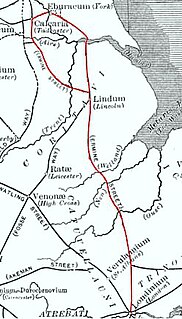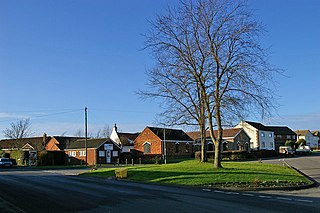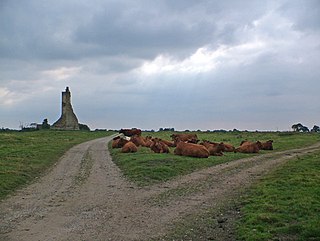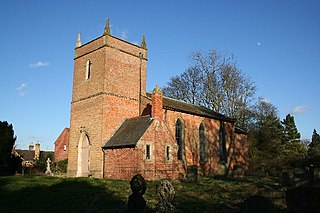
Ermine Street is the name of a major Roman road in England that ran from London (Londinium) to Lincoln and York (Eboracum). The Old English name was "Earninga Straete" (1012), named after a tribe called the Earningas, who inhabited a district later known as Armingford Hundred, around Arrington, Cambridgeshire and Royston, Hertfordshire. "Armingford", and "Arrington" share the same Old English origin. The original Celtic and Roman names for the route remain unknown. It is also known as the Old North Road from London to where it joins the A1 Great North Road near Godmanchester.

The Fosse Way was a Roman road in England that linked Exeter in South West England to Lincoln in Lincolnshire, via Ilchester, Bath, Cirencester and Leicester.

West Lindsey is a local government district in Lincolnshire, England.

The A15 is a major road in England. It runs north from Peterborough via Market Deeping, Bourne, Sleaford and Lincoln along a variety of ancient, Roman, and Turnpike alignments before it is interrupted at its junction with the M180 near Scawby. The road restarts 10 miles (16 km) east, and then continues north past Barton-upon-Humber, crossing the Humber on the Humber Bridge before terminating at Hessle near Kingston upon Hull.

Asgarby is a hamlet in the East Lindsey district of Lincolnshire, England. It lies just south from the B1195, a road that runs past the battlefield at Winceby. Asgarby is on the opposite side of the road to the battlefield.

Withcall is a small farming village and civil parish in the East Lindsey district of Lincolnshire, England. It lies within the Lincolnshire Wolds, and 4 miles (6.4 km) south-west from Louth.

South Killingholme is a village and civil parish in North Lincolnshire, England. The population of the civil parish at the 2011 census was 1,108.

Ashby with Scremby is a civil parish in the East Lindsey district of Lincolnshire, England, with a population of 147, increasing to 179 at the 2011 census. The parish includes the village of Scremby, along with the hamlets of Ashby by Partney and Grebby.

The Viking Way is a long distance trail in England running 147 miles (237 km) between the Humber Bridge in North Lincolnshire and Oakham in Rutland.

Winceby is a village in the civil parish of Lusby with Winceby in the East Lindsey district of Lincolnshire, England. It is situated in the Lincolnshire Wolds, and about 5 miles (8.0 km) from both Horncastle and Spilsby.
Miles Cross Hill is a large hill that is the sloping gradient up to the landscape of the Lincolnshire Wolds. As it is the first large hill of the Wolds, there are views of the Lincolnshire Fens and Coast. The hill leads to Ulceby Cross Roundabout.

Kirkstead is an ancient village and former parish on the River Witham in Lincolnshire, England. It was amalgamated with the civil parish of Woodhall Spa in 1987.

The A158 road is a major tourist route that heads from Lincoln in the west to Skegness on the east coast. The road is located entirely in the county of Lincolnshire and is single carriageway for almost its entirety. The road is approximately 41 miles (66 km) long. The road gets quite congested with holiday traffic during the summer.
The A607 is an A road in England that starts in Leicester and heads northeastwards through Leicestershire and the town of Grantham, Lincolnshire, terminating at Bracebridge Heath, a village on the outskirts of Lincoln. It is a primary route from Thurmaston to the A1 junction at Grantham.

Tetford is a village and civil parish in the East Lindsey district of Lincolnshire, England.
High Dyke is a minor road following a length of the Roman Road Ermine Street in the English county of Lincolnshire, between Woolsthorpe-by-Colsterworth and Ancaster, and onwards nearly to Bracebridge Heath. It is also the name of a small settlement on that road, 1 mile (1.6 km) south-east from Great Ponton, near to the mouth of Stoke Tunnel on the East Coast Main Line. High Dyke is also a name for the general area between Easton and Great Ponton. On the Ordnance Survey 1:25000 sheets it is spelled High Dike.
Greetham with Somersby is a civil parish in the East Lindsey district of Lincolnshire, England. It is situated approximately 3 miles (5 km) north-east from the market town of Horncastle.

The A1500 is an 'A' road entirely within the English county of Lincolnshire. It links the A156 at Marton with the A15 south of RAF Scampton via Sturton by Stow.


























